The role of educators is more challenging and multifaceted than ever before. From lesson planning to grading, managing student engagement, and providing personalized support, teachers often face overwhelming demands. Fortunately, artificial intelligence (AI) offers tools that can ease these burdens while enhancing educational outcomes. In this blog post, we’ll explore how teachers can adopt AI to streamline their day-to-day activities, making education more efficient and effective for everyone involved.
Read Also: You Are Not Late: How to Start Using AI for Your Career Growth
1. AI in Lesson Planning
Creating engaging and effective lesson plans can be time-consuming. AI-powered tools like ChatGPT, LessonUp, or Eduflow can assist teachers by:
- Generating lesson ideas tailored to specific grade levels and subjects.
- Creating quizzes, worksheets, and interactive activities.
- Providing ready-made templates that can be customized to fit classroom needs.
For example, a history teacher can input a topic like “The Renaissance” and receive a structured lesson plan complete with discussion prompts, multimedia resources, and assessment questions.
2. Personalized Learning for Students
AI excels at personalization. Tools like DreamBox and Knewton adapt to individual student’s learning styles and pace, providing tailored exercises and real-time feedback. Teachers can:
- Identify struggling students early through AI-powered analytics.
- Offer targeted interventions to help students improve specific skills.
- Use adaptive platforms to ensure no student is left behind.
3. Grading and Assessment Automation
Grading is one of the most time-consuming tasks for teachers. AI tools like Gradescope and Socrative simplify this process by:
- Automatically grading multiple-choice and fill-in-the-blank questions.
- Providing detailed analytics on student performance.
- Offering tools for easier evaluation of written assignments through AI-generated suggestions.
This allows teachers to focus on providing meaningful feedback rather than spending hours on repetitive tasks.
4. Enhancing Classroom Engagement
Keeping students engaged is a perennial challenge. AI tools can:
- Create interactive and gamified learning experiences using platforms like Kahoot! and Quizizz.
- Generate real-time polls and quizzes to gauge student understanding.
- Suggest multimedia resources, such as videos or virtual reality experiences, to make lessons more captivating.
5. Administrative Support
Managing classroom logistics, parent communication, and scheduling can overwhelm even the most organized teachers. AI tools like TeacherKit and Edmodo help by:
- Automating attendance tracking and grade book management.
- Scheduling parent-teacher meetings and reminders.
- Offering communication platforms to update parents on student progress.
6. Professional Development and Collaboration
AI tools like Coursera and LinkedIn Learning provide professional development opportunities tailored to teachers. Educators can:
- Learn new teaching methodologies and technologies.
- Participate in AI-driven peer collaboration platforms.
- Stay updated with the latest research and trends in education.
7. AI Ethics and Considerations
While adopting AI, it’s crucial to consider ethical implications, such as:
- Ensuring student data privacy and security.
- Avoiding over-reliance on AI to maintain a human touch in education.
- Choosing tools that align with the school’s values and goals.
Final Thoughts
AI is not a replacement for teachers but a powerful ally that can help educators manage their workload, personalize learning, and enhance the classroom experience. By integrating AI into day-to-day activities, teachers can focus more on what they do best: inspiring and educating the next generation.
Call to Action: Ready to revolutionize your teaching methods? Explore AI tools like ChatGPT or Kahoot! today, and see how they can transform your classroom. Share this post with fellow educators who might find these tips helpful!
What AI tools do you use in your classroom? Let us know in the comments below!

